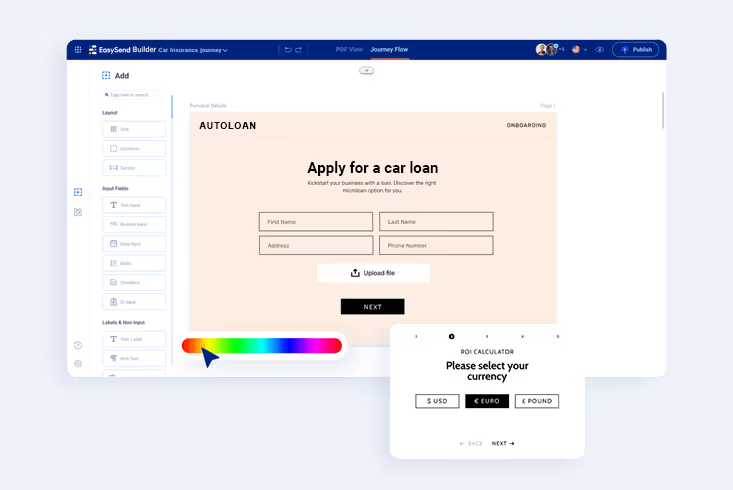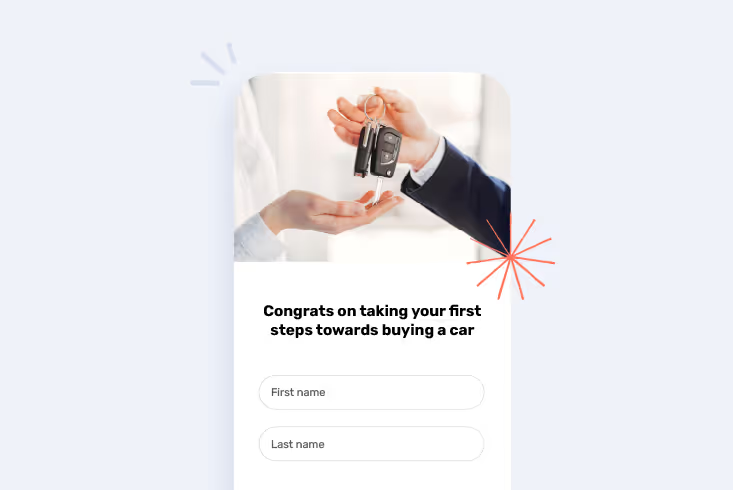Digital transformation of car dealerships
Dealerships are under immense external pressures and will need to find ways to adapt in order to stay competitive throughout the coming years. Countless factors are impacting OEM production and deliveries, making it challenging to maintain profit margins while relying on old strategies. It is time for dealers to embrace digital transformation in order to adapt to ongoing inventory challenges and shifts in consumer behaviors.
Among others, major trends driving digital transformation within the industry include:
- The rise of the digital customer experience as a core competency for dealerships and OEMs
- The growing importance of data management, quality assurance, and governance
- New opportunities in mobility services such as car-sharing or ride-hailing
- The rise of data visualization and analytics for dealerships
- The growth of IoT within the automotive space
Dealerships that will succeed, are the ones that embrace change and proactively adapt to the future. Dealerships are already beginning to take control of their future success by continuing to adapt to industry and buyer behavior trends and focusing on driving profitability with innovative strategies.
[.emph] Digital transformation is no longer an option; it's quickly becoming the only way dealerships can survive. [.emph]
1. No-code/low code development
To stay competitive, dealerships must find ways to simplify and streamline their work by leaning into data and technology.
But setting up and maintaining digital systems is difficult, expensive, and time-consuming. At the same time, automotive dealerships cannot afford to move slower than competitors, considering how quickly the challenges during the pandemic are shifting.
[.emph]No-code apps revolutionize the way automotive industry professionals are conducting their day-to-day operations by making it simple to digitize previously manual processes.[.emph]
What is low-code/no-code development?
Low-code/No-code tools comprise a wide array of types—website generators, form builders, API connectors, database builders, workflow automation tools, and more, each requiring varying levels of technical proficiency. Some are 100% codeless and UI-based with drag-and-drop templates (referred to as no-code tools). Others require support from complement developers (referred to as low-code tools).
No-Code platforms in particular offer development tools for people with absolutely no coding knowledge. These systems work in a combination of Drag&Drop interfaces and templates, which enable business users (referred to as citizen developers) to create new applications to support their work without the need for a single line of code.
Crucially, no-code apps can be built based on existing workflows, spreadsheets, and databases, providing speed and flexibility for dealership businesses at a fraction of the cost of traditional digital solutions.
What is crucial, especially when competition is at its peak, is that these no-code applications are highly customizable and can be updated with just a few clicks. Low-code technology is projected to grow quickly over the coming years.
[.figure]75%[.figure]
[.emph]of companies will have used at least four low-code tools for both IT and citizen developer needs by 2024, Gartner projects.[.emph]
Low-code/no-code platforms help create internal business apps and digital customer journeys without the need for advanced coding knowledge.
Applications of no-code in dealerships
No-code platforms can support the management of all aspects of a dealership:
- Sales Management
- Customer Management
- Vehicle Inventory Management
- Service Management
- Parts Inventory Management
- Finance And Accounting
- Large-scale reporting
- Remote signing
- Online payment processing
Each dealership's operations are different.
[.emph]No-code tools offer a simple and agile way to automate all parts of the business, eliminating bottlenecks, improving productivity, and enhancing existing workflows. [.emph]
No-code apps provide speed and flexibility at a fraction of the cost of traditional digital solutions, making the work of dealerships streamlined and more efficient.
At the same time, no-code apps improve customer experience and empower sales departments to nurture long-lasting relations with clients by empowering dealerships to create digital journeys to support core processes such as quoting, contracts, loan applications, and more.
In short, no-code apps are a game-changer when it comes to transforming and supporting dealership operations in the digital world.

2. Digital journeys to boost automotive sales
The rapid digitalization of the car buying process has introduced a brand-new era. Today, the evolving consumer demands are centered around hyper-personalization and digital experience.
There are new opportunities for growth in the digital world.
[.emph]Industry research finds consumer preference for buying from dealerships that offer a modern, customized buying experience.[.emph]
Over half of respondents noted that they would purchase new vehicles more often if the overall buying processes were improved. Transitioning inefficient paperwork into personalized digital journeys improves customer experience, making the transition from initial interest to purchase much easier.
Buying journeys are becoming ever more complex. Online and mobile channels such as digital marketing campaigns are becoming ever more important, but touchpoints such as in-store visits or exposure to traditional advertising methods like TV commercials or radio ads might precede the purchase.
[.emph]It becomes crucial to offer omnichannel options that let a customer buy your product in the way that they chose.[.emph]
Here digital journeys play a crucial role. Digital journeys comprise a series of triggers and actions that automate your dealership's communications with prospects and customers.
Digital journeys can easily be integrated with your dealership website as well as with the existing internal workflows in the back-end. Typically, the first step of a digital journey is when an online user visits a dealership website. Digital journeys can then be integrated into existing workflows such as credit applications, existing online sales processes, compliance, and contracting processes.
Each auto dealership site can provide consumers with a personalized digital experience. The triggers and actions that comprise a digital journey, as well as its look and feel can be tailored according to each dealership's business requirements.
Digital journeys are highly adaptable to support your workflow, make your day easier and allow you to work more efficiently. As a result, dealerships spend less time pushing paper and eliminate manual and duplicate efforts.
The way that an online visitor moves through a digital journey is dependent on the actions that THEY take, but the workflow itself is designed to match the business needs of the dealership.
Once your digital journeys are set up and running smoothly, your dealership can sit back and reap the benefits. Digital journeys drive the efficiency of a dealership's prospecting efforts while improving ROI.

3. Remote signing and eSignatures
Paperwork and multiple face-to-face meetings have been the norm in the car dealership industry for a long time. However, this is no longer feasible due to changes brought to our daily lives by the pandemic.
[.emph]Digital journeys with signatures allow for simple remote signing between multiple parties, empowering the remote sales processes. [.emph]
A dealership sales process often involves a complex, multi-party journey, whereby each party has a different pathway, but in the end, all that matters is closing the deal while keeping all parties satisfied.
While digital lead generation in auto sales is nothing new, as e-signatures and digital forms are being normalized, customers expect to complete nearly all (if not all) actions when purchasing a vehicle remotely via digital tools. This often includes finalizing purchases, signing lease agreements, or applying for financing remotely via digital journeys.
Closing transactions via remote signing is becoming ever more popular with clients. Dealerships cannot continue to treat inefficient paperwork as the necessary evil and need to find solutions to improve customer experience.

4. Take the data-driven approach
Advances in technology have led to a new era where data is king. Big data has multiple applications in dealerships, and the adoption of Big Data keeps on growing.
Data can be leveraged in three major ways:
- Utilizing predictive analytics tools to identify prospective leads interested in your available inventory
- Delivering hyper-personalized messaging that captures a prospective buyer's attention
- Setting the stage for an excellent customer experience
5. Acquire in-demand pre-owned vehicles
According to a recent report by IHS Markit, the recent global chip shortage has delayed stabilization of supply, and recovery efforts won't start until at least early 2022.
With new vehicle inventories at a historic low, taking a data-driven approach to making inventory decisions is critical. Dealers need to find ways to maximize their portfolios by adopting a data-driven dealership inventory strategy to maximize their entire dealership portfolio.
Acquiring in-demand pre-owned vehicles is key for keeping customers as well as stealing competitor's market share.
[.figure]41.6% [.figure]
[.emph]of used vehicles on dealership lots in 2020 were acquired through a trade-in for a new sale. [.emph]
Recently, research by the auto industry finds that 41.6% of used vehicles on dealership lots in 2020 were acquired through a trade-in for a new sale. This makes it critical that your sales and service teams have up-to-date intelligence regarding in-demand makes and models.
This can be achieved by monitoring for localized sales trends via predictive analytics based on multiple data points such as the estimated trade-in value, maintenance history, and sales history of similar vehicles in the last 30-90 days period.
6. Cultivate homegrown inventory to boost profitability
[.emph]Customers who service their vehicle at the dealership are more than 2.5x more likely to purchase their subsequent vehicle from that same retailer.[.emph]
Facing increasing competition and a lack of means to increase prices, dealers have been making efforts to ensure profitability in any way possible.
As margins shrink and new inventory dwindles, some dealers are leveraging one strategy to drive profitability- homegrown inventories.
This strategy seeks to maximize the profitability of every single vehicle throughout the vehicle lifecycle:
- New vehicle sale
- Return for regular service and maintenance
- Traded-in and reconditioned
- Sold as a pre-owned vehicle.
This strategy is driven by delivering an exceptional customer experience and engaging with existing customers in order to boost loyalty and keep them coming back after that initial sale.
To succeed, this strategy must be supported by a data-driven approach for personalizing the customer experience. Personalization must start from the very first marketing touchpoint and continue throughout the entire duration of the relationship with the customer.
[.emph]Personalized digital journeys powered by predictive analytics deliver messages to customers and prospects at the right time and in the right format, empowering dealerships to maximize ROI at each step of the buying journey.[.emph]
This benefits a dealer's bottom line in numerous ways, starting with converting prospects more efficiently at a higher ROI and boosting the Lifetime Value of every single customer.

7. Behavior prediction technology
Predicting customer preferences has never been more important to the success of your dealership.
Advanced behavior prediction technology enables dealers to take this approach one step further by proactively mapping prospective buyers to available and incoming inventory. As a result, dealers can reduce the number of days a vehicle sits on the lot, maximizing the dealership’s inventory profitability.
8. Hyper-personalization
Maintaining a current customer base is crucial for dealership success. Amid increased competition, dealerships must proactively promote customer loyalty to discourage customer churn to competitors.
Leveraging data-driven insights about their customers, dealers can take advantage of the predictive marketing tools to automatically identify and engage existing customers before they start shopping around with the competition.
Just like with acquiring new customers, the success of a dealer's loyalty marketing efforts hinges on its ability to personalize its approach and deliver an outstanding digital experience.

9. Third-party lead providers vs. owned channels
Dealerships used to rely on large third-party lead providers to fill in their sales pipelines.
Third-party lead providers distribute leads to multiple dealerships at the same time. Crucially, prospects are defined as leads only when they're already deep into the buying cycle. At this stage, it's likely that your competitor is also reaching them.
Now that building customized digital journeys and collecting data on owned channels is becoming more accessible with no-code tools, dealers are shifting their marketing and lead-gen activities in-house.
Contrary to expectations, customers are returning to the dealership market much faster than anticipated. Experts predicted that the average family would delay vehicle purchases in the wake of COVID-19, but buyers are returning to the market quicker than before the pandemic.
According to data from IHS Markit, in April 2020, the average customer re-entry time dipped to 42 months compared to an average of 44-45 months reported from January 2018 through February 2019.
[.emph]Buyers today are also much more likely to purchase instead of lease, influenced by aggressive OEM incentives.[.emph]
To maximize ROI, it's critical for dealers to engage prospects before the competition does. This means reaching out to prospects long before they enter the buying journey.
A data-driven approach to marketing efforts using behavior prediction technology is becoming crucial for dealership success. Rather than competing for lukewarm leads and dealing with shrinking margins, dealerships have the opportunity to proactively create their own leads with digital journeys powered by behavior-predicting technology.

10. Embrace the digital culture
Becoming a digitally enabled organization goes beyond powering operations with technology.
The importance of culture to support digital transformation cannot be overstated. Dealerships must create a culture that embraces change, experimentation, and the spirit of experimentation.
[.emph]Dealerships must support this fundamental shift by supporting the employees with digital tools to support day-to-day activities. [.emph]
But digital culture goes beyond using digital tools to accomplish day-to-day tasks — it represents a fundamental shift in thinking. It requires a culture that supports the continuous exploration of innovative digital tools, environments, and channels to drive the dealership forward.
It’s time to embrace digital culture as a part of your dealership’s DNA.

Conclusion
While no dealership leader could have anticipated the events of 2020, we are facing unprecedented challenges as a result.
Although it is yet unknown what 2021 will bring, dealers can start planning their future success now by taking a proactive approach to sales, marketing, and customer relationship management.
The dealerships that are faring the best in these uncertain times are those that embrace change, anticipate future trends in the industry and adapt their sales and marketing processes to meet new consumer demands and deliver the customer experience buyers want.
Digital journeys powered by data are becoming crucial tools to boost profitability. Engaging with prospects before they enter the buying journey, generating leads on owned channels, as well as improving the buying experience with eSignature powered journeys are all hallmarks of a digital powerhouse dealership.
About EasySend
Easysend’s no-code platform transforms any manual process into a digital customer journey and helps dealerships streamline processes, sell more vehicles faster, cut costs and increase revenues.
Close more deals with eSign on the go: collect legally binding eSignatures from anyone, anywhere, and on any device. Finalize and streamline the signing of sale and lease contracts, financing agreements and more. EasySend is your full transaction management solution that enables better collaboration and workflow management while making closing deals easier for all parties involved.
.avif)



.avif)
.avif)


.avif)
